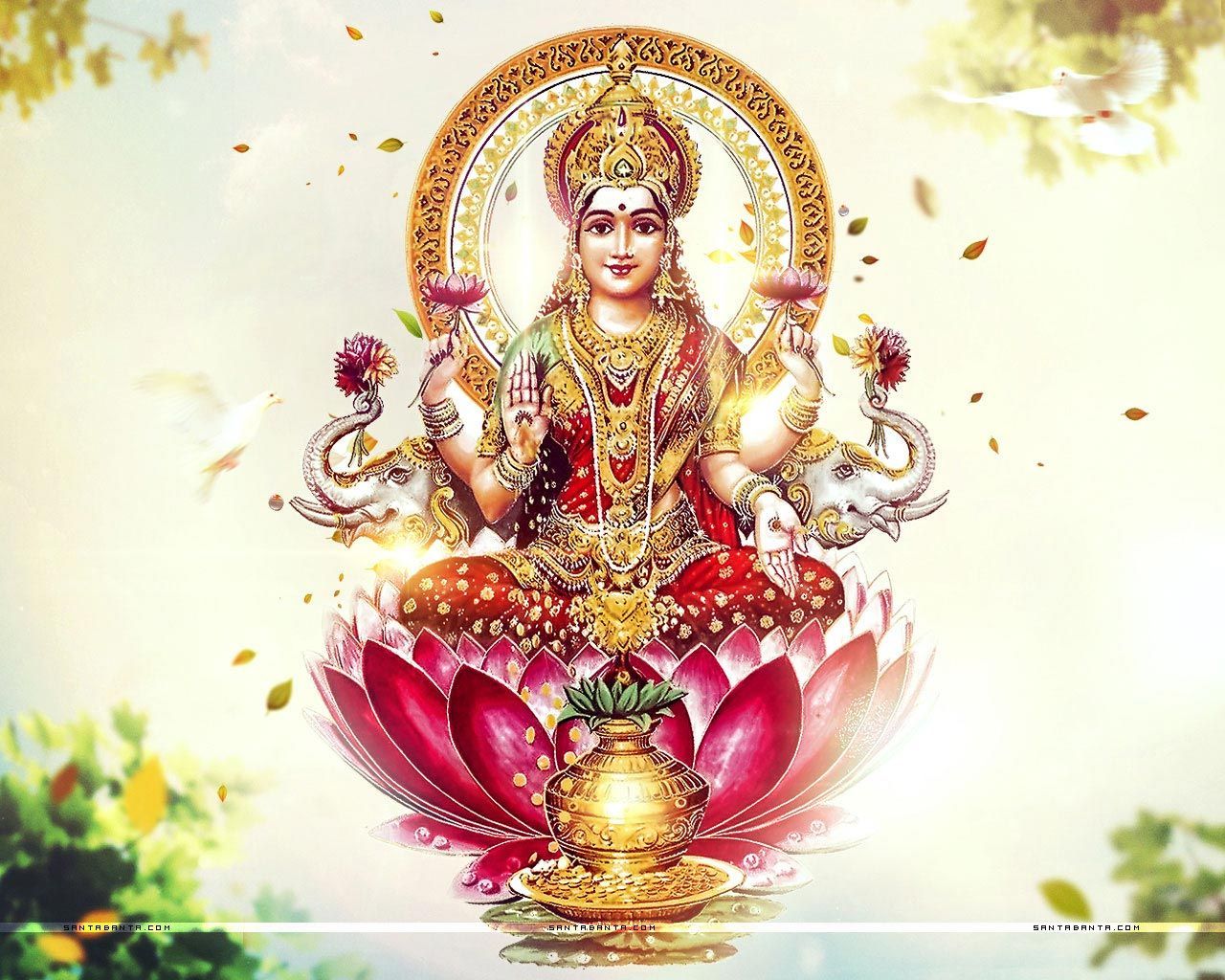
Lakshmi Puja ka din aaya hai Jagmaga raha ye sansar hai Maa ki aaradhna mein talleen hai Apni har manokaamana puri karna ko, Sab leen hai,
Lakshmi Puja ka din aaya ha.
In the verses above, there is a reference to the goddess Shri Lakshmi. The Rig Veda, the earliest of the Hindu scriptures, contains a song about her. As her name implies, Lakshmi is the goddess who bestows riches and prosperity on humans. The word Lakshmi is derived from the Sanskrit word Lakshya, which means objective or goal. This richness might be material or spiritual.
The history of Laxmi Pujan
The goddess Laxmi is the one who represents fortune. Goddess Lakshmi was the daughter of Goddess Durga and the bride of Lord Vishnu. It is said that she appeared beside Lord Vishnu in each of his several avatars.
In addition to bringing us prosperity and mental tranquilly, Goddess Lakshmi also punishes us for our mistakes or unfavourable behaviour. This has a connection to the Lakshmi myth.
Beginning with Lord Indra and Sage Durvasa. As a sign of reverence, Sage Durvasa kneels before Lord Indra and presents him with a garland. Lord Indra disregards it by removing the garland and placing it around the neck of his steed, Airavat. Airavat tosses the garland on the ground out of rage.
Sage Durvasa is enraged by this action, and he curses Lord Indra. According to him, “Your kingdom will be destroyed as a result of your disrespecting my gift of respect, which was a sign of Good Fortune.” Sage Durvasa leaves the area furious after stating this.
Lord Indra begins monitoring the consequences of the curse as he returns to his capital city, Amravati. Gods start acting badly. Plants and other living things start dying. The beast that is inside all living things emerges. Amravati turns becomes a land of demons rather than gods. As the gods’ qualities had changed, the Demons also entered the Amravati region.
What is the solution to it at this point? Lord Indra consults Lord Vishnu for a solution. The only solution, according to Lord Vishnu, is for the ocean to churn. The amrit that will be released from the ocean’s churning can be ingested by the gods, giving them immortality.
The ocean started to churn. The Gods and the Demons were at war with one another. Goddess Lakshmi emerges from this swirling scene sitting on a fully grown lotus. Now that the decision is up to Goddess Lakshmi, she selects Lord Vishnu as her lord and joins the gods’ side. The Gods were able to regain their powers at this point, making it simple to vanquish the devils. As a result of the Demons’ loss, the Gods prevailed.
In this way, Goddess Lakshmi’s appearance on the side of the Gods enabled them accomplish good deeds, be courteous and helpful, acquire their energy, be at peace in their minds, and have the energy to conduct labour. Thus, it follows that Goddess Lakshmi is the patron goddess of both material prosperity and mental tranquilly.
Particular Days When Laxmi Devi Pooja Is Performed
Goddess Lakshmi is revered on the day of Dhanteras, which falls just two days before the Diwali festival. Lakshmi Pujan for Diwali is performed on Dhanteras. Goddess Lakshmi is honoured on the full moon day of the lunar month of Ashwin in West Bengal, Assam, Odisha, and Tripura. On Sharad Purnima or Kojagiri Purnima, the first full moon following Shardiya Navratri, Lakshmi Pooja, also known as Lokkhi Puja or Lokkhi Puja, is observed. On Vijaya Dashami (Dussehra), Kojagari Lakshmi Puja is performed, marking the immersion of the ten-armed Goddess Durga.
Lotus Flower’s Importance in Lakshmi Devi Pujan
Goddess Lakshmi is associated with the lotus flower in the Vedas. Why so? Every God and Goddess in the Vedas is linked to a certain animal or item from the earth. Therefore, since the lotus flower is revered and holy, we must present it to Goddess Lakshmi when we worship her. Goddess Lakshmi loves this flower and finds it pleasing. The Lakshmi Puja Vidhi is concluded with the gift of the Lotus flower to the goddess Lakshmi.
Goddess Lakshmi’s worship customs at Diwali or Laxmi Pujan
Goddess Lakshmi is worshipped, the entire house is properly cleaned, and lovely rangoli is created at the front door of the home on Diwali. Garlands created from marigold and mango leaf flowers and leaves are used to beautify the house. Two unpeeled mangoes are preserved on either side of the Manglik Kalash on either side of the entrance entryway. The statues of the goddess Lakshmi and the god Ganesha are set on an elevated altar that is covered in a crimson fabric. The idols are dressed in tidy, lovely clothing and jewellery.
Women are viewed as the home goddess Lakshmi in several cultures. The diyas are lit and placed all throughout the home. To welcome the Goddess of riches and prosperity, this is done. To do the puja, the residents of the house dress newly.
Then, place a white cloth and nine rice-filled holes, which represent the Navgraha, on the altar’s left side. On the red fabric, there should be sixteen spaces ready for the wheat.
The worship of Lord Ganesha, sometimes referred to as Vigneshwara, kicks off the puja. Lord Ganesha is presented flowers and sweets while a dhoop and an earthen lamp are lit.
Goddess Lakshmi receives tilak on her forehead during the devotion of Lord Ganesha. Dhoop is lit to signal the start of the Lakshmi devi puja. After that, sweets, flowers, and lit clay lamps are presented. The offerings made to Goddess Lakshmi include coriander seeds, cotton seeds, dried whole turmeric, silver coins, currency motes, supari, and lotus flower seeds.
The clay lamp and dhoop are then lit, and Lord Vishnu and Lord Kuber are worshipped. Fruits and flowers are provided.
Goddess Saraswati is then revered. A lamp is lit, and tilak is placed on her forehead. She is the one who bestows to us celestial wisdom and understanding.
Mantra of Maa Lakshmi
“Shreem Swaha”
108 times must be chanted.
To invite all eight manifestations of Goddess Lakshmi, the Shri Suktam from the Rigveda is chanted.
On Diwali, the family members walk outdoors and light fireworks once the lakshmi puja is over. The act of setting firecrackers on fire represents how we drive evil spirits away. The family members, together with their friends and relatives, partake in a special meal.
Lokkhi Kojagari Puja
when, after a full day of fasting, the Kojagari Vrata is performed in front of Lakshmi’s statue in the moonlight. The Vrat is broken by giving flattened rice and coconut water to Goddess Lakshmi after the evening worship is finished.
Numerous gifts are made to the goddess Lakshmi in order to win her favour. The dishes that are made include “Khichuri,” “taaler phopol,” “narkel bhaja,” and “naru,” among others.
To appease the Goddess and elicit Her heavenly favours, various sacrifices like “taaler phopol,” “narkel bhaja,” “naru,” and certain sweets are made.
The Kojagari term derives from the phrase “Ko jagorti,” which means “Who is awake.” On the day of the full moon, it is thought that Goddess Lakshmi descends to Earth. The diyas are therefore left outside the home to welcome her.
To welcome her, people continue singing mantras and shlokas, which is also seen as being highly fortunate.
When she first arrives on Earth, she wanders around and examines the people, during which she inquires, “Who is awake?” She bestows her heavenly graces on those who pay attention to her and respond to her.
The footprints known as “Alpanad” are drawn by worshippers to welcome Goddess Lakshmi into their houses.
Lakshmi Puja: The Day’s Importance
This blessed day is known as a “Day of New Beginning.” The old accounts are all closed, and new initiatives are started. On this day, people tend to start new endeavours, make new purchases, or make investments. All of the old accounting records have been closed, as well as all negative events.
Jains celebrate Diwali
The purpose of the Jain Diwali Puja is to mark the day on which Lord Mahavir attained Moksha, or liberation from the cycle of rebirth. The previous Tirthankar, he was. In the Jain Scriptures, Diwali was initially called Dipalikaya. The phrase “light exiting the body” is called “Dipalikaya.” According to their religious texts, to commemorate the day of Lord Mahavir’s enlightenment, the earth and the skies were lit. Jains commemorate it by igniting the lights and giving out candy. They also observe fasts, sing hymns, and recite mantras in Lord Mahavir’s honour. They celebrate their New Year by chanting “Saal Mubarak” on the day after Diwali.
In 2022, Kojagara Puja will be held on October 9 and Diwali will be held on October 24.
Lakshmiji ka aavahan karein,
Ghar ko saaf aur sudh karein
Sab ka samman karien
Aur apna jivan ko samruddh karein.
